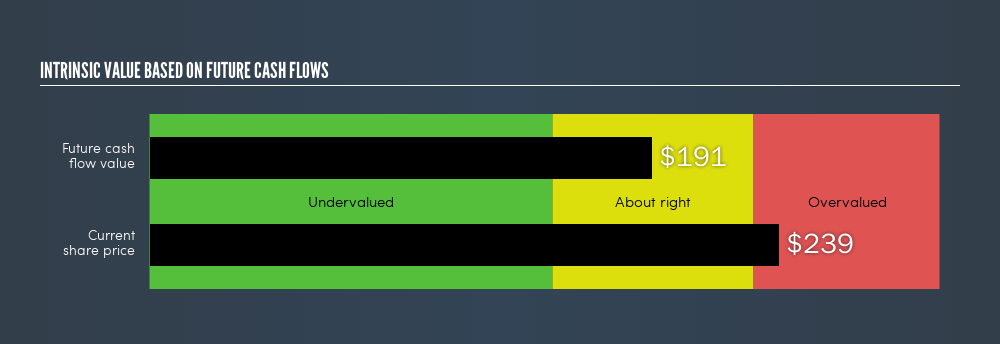- United States
- /
- Banks
- /
- NYSE:BAP
Is Credicorp Ltd. (NYSE:BAP) Expensive For A Reason? A Look At The Intrinsic Value
Want to participate in a short research study? Help shape the future of investing tools and receive a $20 prize!
Bank stocks such as BAP are hard to value. This is because the rules banks face are different to other companies, which can impact the way we forecast their cash flows. The tiered capital structure is common for banks to abide by, in order to ensure they maintain a sufficient level of cash for their customers. Emphasizing data points such as book values, as well as the return and cost of equity, can be beneficial for gauging BAP’s value. Below I’ll look at how to value BAP in a relatively useful and uncomplicated way.
Check out our latest analysis for Credicorp
What Model Should You Use?
Financial firms differ to other sector firms primarily because of the kind of regulation they face and their asset composition. Financial firms operating in Bermuda face strict financial regulation. In addition, banks tend to not hold substantial amounts of tangible assets as part of total assets. Excess Returns overcome some of these issues. Firstly, it doesn't focus on factors such as capex and depreciation - relevant for tangible asset firms - but rather emphasize forecasting stable earnings and book values.

Deriving BAP's True Value
The central assumption for Excess Returns is, the value of the company is how much money it can generate from its current level of equity capital, in excess of the cost of that capital. The returns in excess of cost of equity is called excess returns:
Excess Return Per Share = (Stable Return On Equity – Cost Of Equity) (Book Value Of Equity Per Share)
= (0.18% – 12%) x PEN367.78 = PEN23.8
We use this value to calculate the terminal value of the company, which is how much we expect the company to continue to earn every year, forever. This is a common component of discounted cash flow models:
Terminal Value Per Share = Excess Return Per Share / (Cost of Equity – Expected Growth Rate)
= PEN23.8 / (12% – 2.7%) = PEN266.98
These factors are combined to calculate the true value of BAP's stock:
Value Per Share = Book Value of Equity Per Share + Terminal Value Per Share
= PEN367.78 + PEN266.98 = PEN634.76 ($191.19)
This results in an intrinsic value of $191.19. Relative to today's price of US$239, BAP is trading above what it's actually worth. This means BAP isn't an attractive buy right now. Valuation is only one part of your investment analysis for whether to buy or sell BAP. Fundamental factors are key to determining if BAP fits with the rest of your portfolio holdings.
Next Steps:
For banks, there are three key aspects you should look at:
- Financial health: Does it have a healthy balance sheet? Take a look at our free bank analysis with six simple checks on things like bad loans and customer deposits.
- Future earnings: What does the market think of BAP going forward? Our analyst growth expectation chart helps visualize BAP’s growth potential over the upcoming years.
- Dividends: Most people buy financial stocks for their healthy and stable dividends. Check out whether BAP is a dividend Rockstar with our historical and future dividend analysis.
For more details and sources, take a look at our full calculation on BAP here.
We aim to bring you long-term focused research analysis driven by fundamental data. Note that our analysis may not factor in the latest price-sensitive company announcements or qualitative material.
If you spot an error that warrants correction, please contact the editor at editorial-team@simplywallst.com. This article by Simply Wall St is general in nature. It does not constitute a recommendation to buy or sell any stock, and does not take account of your objectives, or your financial situation. Simply Wall St has no position in the stocks mentioned. Thank you for reading.
About NYSE:BAP
Credicorp
Provides various financial, insurance, and health services and products in Peru and internationally.
Undervalued with excellent balance sheet and pays a dividend.
Similar Companies
Market Insights
Weekly Picks

Early mover in a fast growing industry. Likely to experience share price volatility as they scale


A case for CA$31.80 (undiluted), aka 8,616% upside from CA$0.37 (an 86 bagger!).


Moderation and Stabilisation: HOLD: Fair Price based on a 4-year Cycle is $12.08
Recently Updated Narratives

Airbnb Stock: Platform Growth in a World of Saturation and Scrutiny

Clarivate Stock: When Data Becomes the Backbone of Innovation and Law

Adobe Stock: AI-Fueled ARR Growth Pushes Guidance Higher, But Cost Pressures Loom
Popular Narratives


Crazy Undervalued 42 Baggers Silver Play (Active & Running Mine)


NVDA: Expanding AI Demand Will Drive Major Data Center Investments Through 2026


MicroVision will explode future revenue by 380.37% with a vision towards success
Trending Discussion


